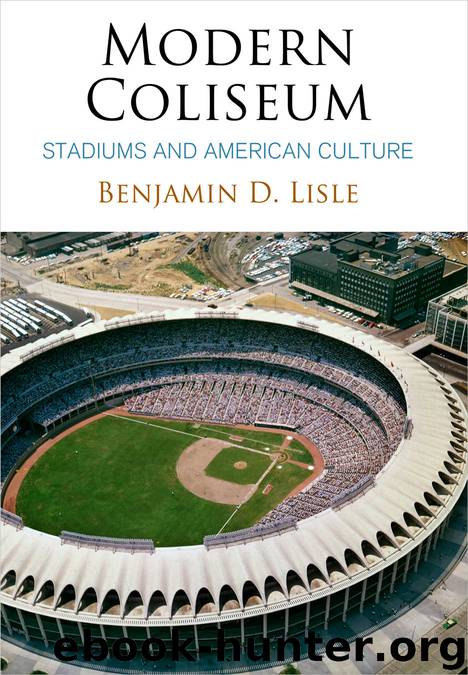Modern Coliseum by Lisle Benjamin D.;

Author:Lisle, Benjamin D.;
Language: eng
Format: epub
Publisher: University of Pennsylvania Press
Published: 2017-03-14T04:00:00+00:00
The Modern Spectator and a Democracy of Comfort
Houston mayor Louis Welch suggested the stadium’s earthbound progressiveness in the opening pages of Inside the Astrodome, when he linked the stargazing aspirations of Houstonians to “prosperity, culture, and contentment.”105 The stadium on one hand could be a symbol of the technological mind and masculine control; on the other it was a material entity that satisfied and validated Houstonians’ mundane desires for comfort and entertainment. Alongside celebrations of technological progressiveness were tributes to the stadium’s many comforts and luxuries that set it apart from stadiums of the past, recasting it as an upscale space where not only Houston’s jet set and oil barons could see, be seen, and seal their big-money deals with firm handshakes but also Houston’s hoi polloi could enjoy a “democracy of goods” and partake in the consumable prosperity of postwar progress.
Hofheinz, the HSA, and like-minded newspapermen embraced the seemingly contradictory notion that the Astrodome was a site of both equality and distinction, a place where everyone enjoyed the material fruits of modern progress—though, presumably, some more “equally” than others. Hofheinz bragged to a New York Times reporter: “Now let’s talk about real grandeur, about the guy who spends $1.50 to see a ball game, and can sit on a foam rubber [seat], and have a reasonable meal without having to eat hot dogs. If we’ve established grandeur we’ve done it for the bleacher fan and the country club member.”106 Inside the Astrodome proclaimed, “Sit down sports fan! Your day is here. A ticket to the Astrodome makes you a king . . . for the first time in sports history you can watch a baseball game from deep-cushioned, foam-padded, nylon-upholstered chairs. You will be able to sit in a chair as comfortable as any found in the world’s finest theatres and opera houses.”107 Visitors were told that the days of hard bleachers were over, as there was “a seat for everyone from pavilion to luxury boxes.” Gary Cartwright, of the Dallas News, alleged curiously, “This is EVERY MAN’S STADIUM—from the cushioned center field section at $1.50 to the upper rim of blue suites which can be grabbed for $18,000 a year”—a claim that was reprinted in the souvenir guide.108 Cartwright’s formulation at once appropriated the democratic suggestiveness of the “every man” and gutted it of this meaning; for him, “every man” didn’t signify the typical or the ordinary but rather each person’s socioeconomic distinctiveness and ability to pay. This wasn’t a democracy of equality but merely the right to consume at whatever level one could afford.109
This conflation of equality and hierarchy—the idea that equality meant access to elevated, though still differentiated, degrees of comfort and luxury—was shot through the stadium’s interior spaces and discourse, most obviously in the presentation of stadium restaurants available (and unavailable) to customers. The stadium featured five separate restaurants, ranging from the elite Skydome Club, restricted to occupants of the luxury boxes and featuring a view of downtown Houston from its 210-foot-long glass window, to
Download
This site does not store any files on its server. We only index and link to content provided by other sites. Please contact the content providers to delete copyright contents if any and email us, we'll remove relevant links or contents immediately.
| Anthropology | Archaeology |
| Philosophy | Politics & Government |
| Social Sciences | Sociology |
| Women's Studies |
Nudge - Improving Decisions about Health, Wealth, and Happiness by Thaler Sunstein(7255)
iGen by Jean M. Twenge(5166)
The Fire Next Time by James Baldwin(5024)
Adulting by Kelly Williams Brown(4240)
The Hacking of the American Mind by Robert H. Lustig(4092)
The Sports Rules Book by Human Kinetics(4079)
The Ethical Slut by Janet W. Hardy(4042)
Captivate by Vanessa Van Edwards(3732)
Mummy Knew by Lisa James(3522)
In a Sunburned Country by Bill Bryson(3374)
The Worm at the Core by Sheldon Solomon(3327)
Ants Among Elephants by Sujatha Gidla(3282)
Suicide: A Study in Sociology by Emile Durkheim(2908)
The Slow Fix: Solve Problems, Work Smarter, and Live Better In a World Addicted to Speed by Carl Honore(2843)
The 48 laws of power by Robert Greene & Joost Elffers(2817)
Humans of New York by Brandon Stanton(2690)
Handbook of Forensic Sociology and Psychology by Stephen J. Morewitz & Mark L. Goldstein(2605)
The Happy Hooker by Xaviera Hollander(2586)
The Tipping Point by Malcolm Gladwell(2563)
